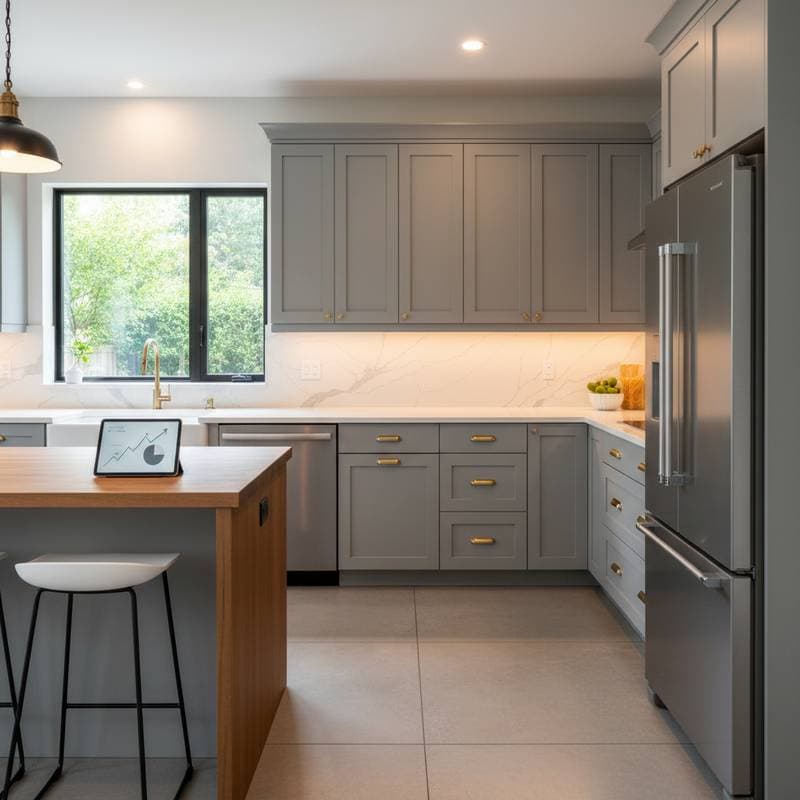Kitchen Upgrades That Maximize Return on Investment
Homeowners often find their kitchens no longer meet modern needs for efficiency or style. Targeted renovations address these issues while enhancing property value. Focus on upgrades that balance initial costs with long-term benefits to achieve optimal returns.
This article examines proven kitchen improvements, including cost estimates and selection criteria. Readers gain insights into projects that yield strong financial rewards alongside practical advantages.
Establishing a Strategic Remodel Approach
Develop a clear framework before initiating any kitchen project. This approach evaluates options based on financial return, everyday usability, and local market fit.
Consider these core elements:
- Cost-to-Value Assessment: Select renovations that recoup at least 60 percent of expenses upon resale.
- Durability and Utility: Choose features that streamline routines and demand little upkeep over time.
- Alignment with Local Standards: Tailor improvements to neighborhood expectations to prevent excess spending.
Such a framework ensures renovations support immediate enjoyment and future profitability.
Cabinet Refacing: A High-Impact, Cost-Effective Update
Cabinet refacing transforms worn cabinetry without the expense of full replacement. Professionals remove doors and drawers, then apply new veneers, hardware, and finishes to existing frames. This method refreshes the kitchen's appearance while preserving structural integrity.
Average costs range from $4,000 to $8,000 for a standard kitchen, depending on size and material choices. Expect a 70 percent return on investment, as buyers appreciate the updated look at a fraction of new cabinet prices.
Opt for solid wood veneers or thermofoil for durability. Pair refacing with new soft-close hinges and pulls to elevate functionality. Homeowners report immediate satisfaction from the streamlined process, often completed in one to two weeks with minimal disruption.
Selecting Countertops for Lasting Appeal and Performance
Countertops serve as focal points that influence buyer perceptions and daily tasks. Prioritize materials that resist wear while complementing the overall design.
Review these options in the table below:
| Material | Cost per Square Foot | Maintenance Requirements | Estimated ROI |
|---|---|---|---|
| Quartz | $60 to $100 | Low | 70% |
| Granite | $50 to $90 | Medium | 65% |
| Butcher Block | $40 to $70 | High | 55% |
| Laminate | $20 to $40 | Low | 50% |
Quartz offers nonporous surfaces ideal for busy households, resisting stains and bacteria. Granite provides natural elegance but requires periodic sealing to maintain its luster.
Incorporate design elements like waterfall edges during installation. These additions create visual interest and expand usable space without extensive modifications.
Upgrading Appliances for Efficiency and Style
Appliance replacements enhance operational performance and energy use. Select models certified by ENERGY STAR to qualify for rebates and lower utility bills.
A complete set typically costs $2,000 to $8,000. These investments yield about 60 percent ROI through improved efficiency and broad buyer appeal.
Focus on high-use items such as refrigerators and dishwashers first. Energy savings often offset costs within three to five years. Stainless steel exteriors align with contemporary tastes, though matte black options suit transitional designs.
Install smart features like Wi-Fi connectivity for remote monitoring. This modern touch appeals to tech-savvy buyers and simplifies maintenance.
Allocating Budget and Managing Project Timeline
Effective planning controls expenses and timelines for kitchen renovations. Allocate funds across key areas to maximize impact.
Sample budget distribution for a $20,000 project:
- Cabinets (including refacing): 35 percent
- Appliances: 20 percent
- Countertops: 15 percent
- Flooring: 10 percent
- Lighting and accessories: 10 percent
- Reserve for unexpected costs: 10 percent
Mid-range refreshes fall between $12,000 and $25,000, varying by location and scope. Sequence tasks—starting with demolition and cabinets—to finish in three to six weeks.
Consult local contractors early for accurate quotes. Secure permits if structural changes are involved. Track progress with a simple timeline to stay on course.
Flooring and Lighting: Subtle Enhancements with Strong Returns
Flooring and lighting often receive less attention but contribute significantly to ambiance and utility. Durable options like luxury vinyl plank withstand moisture and traffic while mimicking hardwood at lower costs.
Expect $3,000 to $6,000 for flooring installation, with 50 to 60 percent ROI. LED under-cabinet lights improve task visibility and energy efficiency, costing $500 to $1,500.
Choose warm-toned LEDs for inviting atmospheres. Combine with recessed ceiling fixtures to eliminate shadows. These upgrades create a cohesive, well-lit space that enhances cooking and gathering.
Safeguarding and Extending Your Renovation Benefits
Protect new installations through routine practices to preserve value. Schedule annual inspections for appliances and surfaces to address issues promptly.
Use protective mats under heavy appliances to prevent floor damage. Clean quartz or laminate counters with mild soap to avoid residue buildup. For refaced cabinets, apply gentle cleaners and avoid excessive moisture near seams.
Regular upkeep ensures the kitchen remains a standout feature. Homeowners who maintain these elements report sustained appeal and fewer repair needs over time. This diligence translates to higher resale offers and prolonged enjoyment.
